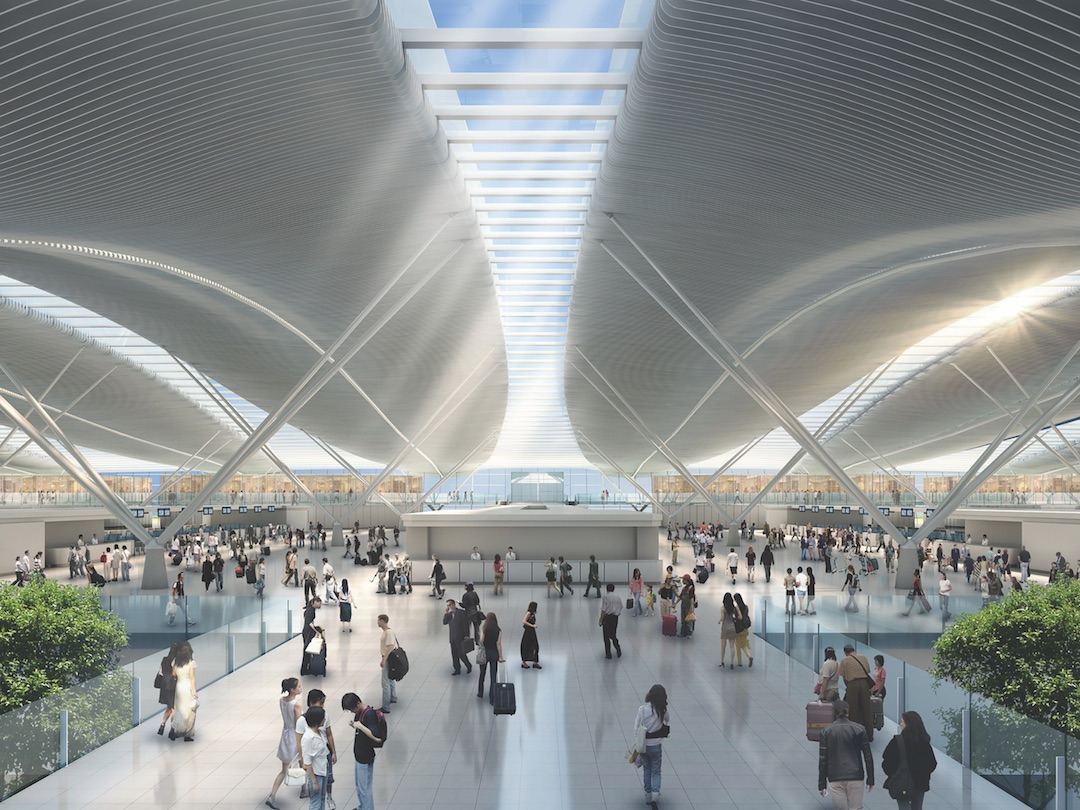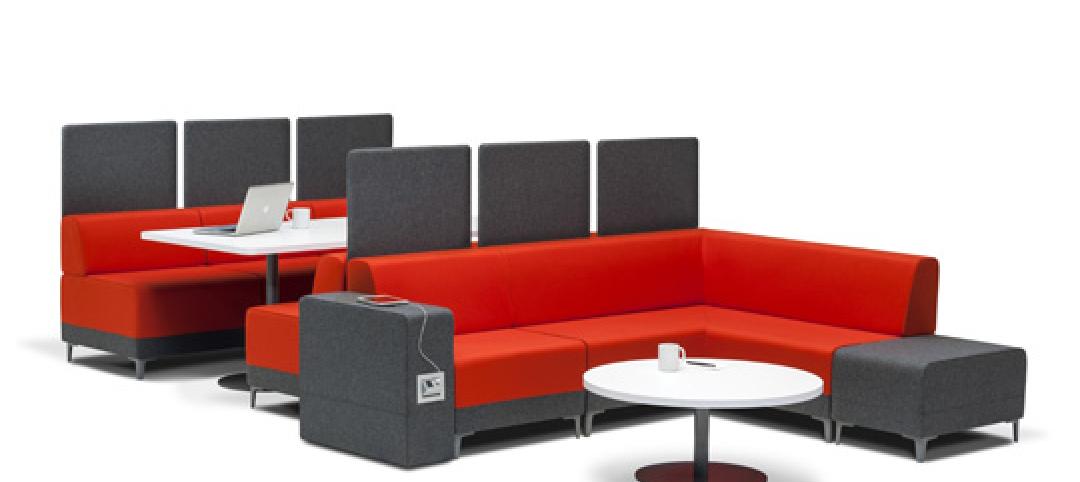Domestic and foreign airlines serving the U.S. carried an all-time high of 965 million passengers in 2017, according to the U.S. Department of Transportation. Airports Council International estimates that 8.8 billion flyers used airports worldwide last year, up 6.6%.
Airport operators everywhere are scrambling to keep pace. “Construction and expansion of airports is growing at a rate of 5–10% or more around the world,” says Jay Fraser, Vice President/General Manager of Turner Construction’s Aviation Group. Turner is adding a three-level, 50,500-sm international port at Cam Ranh International Terminal in Vietnam to handle 2.5 million passengers a year.
Turner and PLC Construction Services are working on the Federal Inspection Services (FIS) Relocation and Expansion project at San Diego International Airport’s Terminal 2 West, which will house Customs and Border Protection services.
U.S. AEC aviation-sector firms are benefiting from the high level of deferred investment in infrastructure, airline profitability, and the strength of the dollar, note Keith Thompson and Terence Young, Principals in Gensler’s Los Angeles office.
See also: Top 45 Airport Facilities Architecture + AE Firms - 2018 Giants 300 rankings
See also: Top 55 Airport Facilities Engineering + EA Firms - 2018 Giants 300 rankings
See also: Top 55 Airport Facilities Contractors + CM Firms - 2018 Giants 300 rankings
Skidmore, Owings & Merrill is lead designer for the new 450,000-sf International Arrivals Facility at Seattle-Tacoma International Airport. It will add eight gates for widebody aircraft and 50 more passport checkbooths and kiosks.
AEC firms that practice design-build or integrated design delivery methods and are open to public-private partnerships are in the sweet spot for airport projects. “Clients are looking at delivery models that save money and time,” says Bijan Pashanamaei, PE, Director of AECOM Global Aviation.
He notes that the design and build portions for the modernization of Phoenix Sky Harbor International Airport’s Terminal 3 were wrapped into a single contract that included DWL Architects + Planners, SmithGroupJJR, and Corgan.
AEC firms are using quicker delivery methods incorporating modular and prefabricated components. “Many clients start with the desire for modular construction," meaning offsite assembly to minimize on-site disruption to ongoing operations, says SOM Director Derek Moore. “This makes sense at very busy airports with little elbow room for traditional construction.”
Mortenson Construction used “substantial fabrication” to deliver an Alternate Utility Facility to support Port of Seattle’s SeaTac airport in the case of disruptive high-wind events, says Mark Baughmam, DBIA, LEED AP, a Construction Executive with Mortenson.
using technology to ease travel anxiety
Turner's Jay Fraser calls technology “the most critical design advancement” for airports. At the FIS facility in San Diego, interactive wayfinding displays and self-boarding gates that
enable planes to load without attendants are being installed.
One new feature at airport gates is a “hearing loop,” which wirelessly transmits boarding announcements to hearing-impaired passengers via their hearing aids or cochlear implants.
“The expectation of technology continues to grow project to project,” says Michael C. Braun, AIA, LEED AP, Executive Vice President with DWL. “Almost every seat has access to power, and the Wi-Fi has excellent coverage. The design must integrate these components in a way that allows them to operate without undermining the architectural features.”
shopping malls with planes
Airports are also revving up their retail and food services. “Unlike struggling malls, airports have a constant source of potential shoppers,” says Kelsey Chesney, Vice President and Senior Brand Strategist, FRCH Design Worldwide.
The design of travel retail has been shifting from a purely efficient, commodity-based model to a targeted, experienced-based one, says Kevin Horn, LEED GA, CallisonRTKL’s Vice President. Airport store designs are showcasing unique local merchandise. “Shop-in-shop” layouts highlight brands and allow flyers to engage products physically and digitally.
Horn notes that some travelers actually route their trips through two of his firm’s recent projects—Inchon International Airport in South Korea and Changi International in Singapore—to take advantage of their expansive retail offerings.
Airports, says Chesney, are becoming “self-contained cities” and homes away from home for frequent flyers. Fitness and wellness centers are popping up in airports. SOM’s Moore is seeing children’s play areas, ubiquitous electrical outlets, premium lounges, and short-term sleeping rooms.
See Also: Retail's age of experimentation
“Adding seasonal outdoor spaces post security, interior landscaping and water features, and commissioned works of art are fast developing as distinguishing features of terminal design to create a sense of place,” says Moore.
In some of its recent airport projects, Gensler has introduced a town square concept that offers spaces for concerts, fashion shows, dance presentations, and local artists’ exhibits, along with meditation and yoga rooms.
This “sense of place” extends to how an airport building is positioned vis-à-vis its outdoor surroundings. DWL’s design for Scottsdale (Ariz.) Airport’s new 23,898-sf Aviation Business Center, says Braun, integrates shaded glass façades to enhance visitors' views of the nearby McDowell Mountains.
This $27 million Terminal Area Redevelopment project, which will expand two hangars, is transforming Scottsdale Airport from a corporate, general aviation reliever facility into "a community resource and a point of pride for the city,” says Braun.
Related Stories
| Jul 2, 2014
Emerging trends in commercial flooring
Rectangular tiles, digital graphic applications, the resurgence of terrazzo, and product transparency headline today’s commercial flooring trends.
| Jun 30, 2014
Arup's vision of the future of rail: driverless trains, maintenance drones, and automatic freight delivery
In its Future of Rail 2050 report, Arup reveals a vision of the future of rail travel in light of trends such as urban population growth, climate change, and emerging technologies.
| Jun 18, 2014
Arup uses 3D printing to fabricate one-of-a-kind structural steel components
The firm's research shows that 3D printing has the potential to reduce costs, cut waste, and slash the carbon footprint of the construction sector.
| Jun 12, 2014
Austrian university develops 'inflatable' concrete dome method
Constructing a concrete dome is a costly process, but this may change soon. A team from the Vienna University of Technology has developed a method that allows concrete domes to form with the use of air and steel cables instead of expensive, timber supporting structures.
| Jun 2, 2014
Parking structures group launches LEED-type program for parking garages
The Green Parking Council, an affiliate of the International Parking Institute, has launched the Green Garage Certification program, the parking industry equivalent of LEED certification.
| May 29, 2014
7 cost-effective ways to make U.S. infrastructure more resilient
Moving critical elements to higher ground and designing for longer lifespans are just some of the ways cities and governments can make infrastructure more resilient to natural disasters and climate change, writes Richard Cavallaro, President of Skanska USA Civil.
| May 23, 2014
Top interior design trends: Gensler, HOK, FXFOWLE, Mancini Duffy weigh in
Tech-friendly furniture, “live walls,” sit-stand desks, and circadian lighting are among the emerging trends identified by leading interior designers.
| May 20, 2014
Kinetic Architecture: New book explores innovations in active façades
The book, co-authored by Arup's Russell Fortmeyer, illustrates the various ways architects, consultants, and engineers approach energy and comfort by manipulating air, water, and light through the layers of passive and active building envelope systems.
| May 19, 2014
What can architects learn from nature’s 3.8 billion years of experience?
In a new report, HOK and Biomimicry 3.8 partnered to study how lessons from the temperate broadleaf forest biome, which houses many of the world’s largest population centers, can inform the design of the built environment.
| May 13, 2014
19 industry groups team to promote resilient planning and building materials
The industry associations, with more than 700,000 members generating almost $1 trillion in GDP, have issued a joint statement on resilience, pushing design and building solutions for disaster mitigation.

















